- What We Do
- Agriculture and Food Security
- Democracy, Human Rights and Governance
- Economic Growth and Trade
- Education
- Ending Extreme Poverty
- Environment and Global Climate Change
- Gender Equality and Women's Empowerment
- Global Health
- Water and Sanitation
- Working in Crises and Conflict
- U.S. Global Development Lab

July 13, 2017
Food Security Situation
-
The Democratic Republic of Congo (DRC) continues to experience high levels of insecurity, prompting population displacement and reducing access to agricultural land and markets. Approximately 3.8 million Congolese are internally displaced. DRC also hosts more than 470,000 refugees from nearby countries, including Burundi, Central African Republic, Rwanda, and South Sudan.
-
Of an estimated population of 80 million people, nearly 5.9 million Congolese were acutely food-insecure as of early 2017, according to UN estimates. Recent normal harvests in DRC’s northeastern provinces have improved food security conditions, with those populations expected to face Minimal (IPC 1) levels of food insecurity through September, according to the USAID-funded Famine Early Warning Systems Network (FEWS NET). However, households in other areas will likely experience Stressed (IPC 2) or Crisis (IPC 3) levels due to conflict and poor harvests.
-
Increased violence in recent months in DRC’s Kasais region—where 1.4 million people have been displaced since August 2016—has caused deteriorating food security conditions; the UN estimated that 42 percent of households in the Kasais were food-insecure as of late May.
Food Assistance Programs
-
USAID’s Office of Food for Peace (FFP) provides emergency food assistance through implementing partners to vulnerable, conflict-affected populations using Title II U.S. in-kind food, locally and regionally procured food, cash transfers, and food vouchers. With this flexible approach, FFP is able to use the most efficient, appropriate tools to maximize program impact and reduce costs.
-
FFP partners with the UN World Food Program (WFP) to provide U.S. in-kind food and locally and regionally purchased food for refugees, internally displaced persons (IDPs), and vulnerable host communities in conflict-affected areas of eastern DRC. Through WFP, FFP supports general food distributions; targeted supplementary feeding for acutely malnourished children and pregnant and lactating women; support to caretakers of malnourished children in therapeutic feeding centers; and blanket supplementary feeding to prevent acute malnutrition in children aged 6-23 months and pregnant and lactating women. FFP also supports recovery activities, including food-for-assets and food-for-training, for highly food-insecure IDPs. In addition, FFP partners with the UN Children’s Fund (UNICEF) to address severe acute malnutrition in children in eastern and central DRC.
-
With USAID’s Office of U.S. Foreign Disaster Assistance (OFDA), FFP jointly funds non-governmental organization (NGO) partners Samaritan’s Purse, the Agency for Technical Cooperation and Development, and Catholic Relief Services (CRS), thereby saving on program costs and providing a multi-sectoral package of humanitarian assistance to newly displaced populations.
-
Furthermore, FFP funds NGOs CRS, Food for the Hungry, and Mercy Corps for longer-term development food assistance projects to improve agricultural capacity, maternal and child health and nutrition, civil participation and local governance, disaster risk reduction, water and sanitation, natural resource management and biodiversity, and microenterprise productivity.
-
To date in FY 2017, FFP has provided approximately $62 million for emergency and development efforts in DRC.
Food for Peace Contributions
Total Contributions:
| U.S. Dollars | Metric Tons | |
|---|---|---|
| Fiscal Year 2017 | $61.8 million | 28,716 MT |
| Fiscal Year 2016 | $80.3 million | 44,125 MT |
Fiscal Year 2017 Contribution Breakdown To Date:
| U.S. Dollars | Metric Tons | |
|---|---|---|
| Title II Development | $7 million | ---- |
| Title II Emergency | $29.8 million | 15,590 MT |
| Emergency Food Security Program (EFSP) | $25 million | 13,126 MT |
The Integrated Food Security Phase Classification (IPC) is a standardized tool that aims to classify the severity and magnitude of food insecurity. The IPC scale, which is comparable across countries, ranges from Minimal—IPC I—to Famine—IPC 5.
Funding contributions for fiscal years include both emergency and development funding.
FY 2017 contributions based on funds obligated to date.
Contributions do not include FFP assistance to Central African refugees living inside DRC.
EFSP: Emergency Food Security Program.
Related Resources
Final Democratic Republic of Congo FY 2016 Country Specific Information
Food Security Desk Review For Katanga, North Kivu, and South Kivu, Democratic Republic of Congo
Food Security Desk review for Kasai Occidental and Kasai Oriental, Democratic Republic of Congo
Democratic Republic of the Congo Staple Food Market Fundamentals







Comment
Make a general inquiry or suggest an improvement.